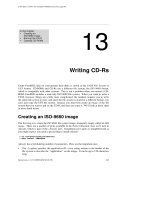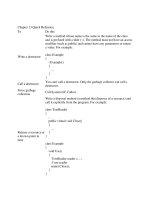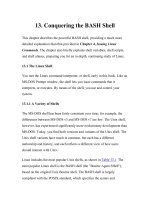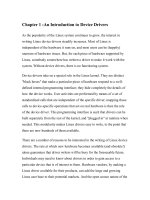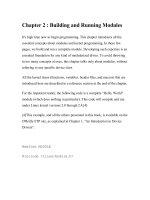linux crash course chapter 13 3
Bạn đang xem bản rút gọn của tài liệu. Xem và tải ngay bản đầy đủ của tài liệu tại đây (196.79 KB, 19 trang )
Chapter 13:
sed
Say what?
In this chapter …
•
•
•
•
•
•
•
Basics
Programs
Addresses
Instructions
Control
Spaces
Examples
sed
•
•
•
•
GNU sed (stream editor)
Noninteractive, batch editing
Good for repetitive tasks
Often used in a pipe
sed syntax
• Syntax:
sed [options] program [filelist]
sed [options] program-file [filelist]
• Program is a set of commands for editing
– Can either be issued on the command line or
placed into a file (like gawk)
• Filelist is a list files to edit
– If omitted, input taken from standard in
sed syntax con’t
• Options
--in-place[=suffix]
• Instead of sending edited text to standard out, write
changes back to input file
• Adding =suffix makes backup of original file
-n
• Do not send lines to output unless program explicitly
says to
Programs
• sed programs contain one or more lines with
the following syntax:
[address[,address]] instruction [args]
• Simple one or two line programs can be
issued at the command line
• More complex programs are usually best put
in a program file
How sed works
1. Read one line of input
2. Read first instruction in program. If the
address(es) select this line, runs the
instruction on this line
3. Repeat #2 for each line in the program
4. Read next line of input and go back to step
2, until there are no more lines of input
Addresses
• Select which lines are to be processed
• Can be a simple integer (line number) or a
regular expression (pattern matching)
• Address $ represents last line of input
• If address omitted, all lines processed by
default
• If there is one address, only lines that match
will be processed
Addresses con’t
• If two addresses are given, it selects a range
• Once the first address is matched, it and
subsequent lines are processed until the
second address is matched
• If second address is never matched,
processes remainder of lines
• If second addressed matched, sed will then
try to match first address again
Instructions
• d – does not write out (deletes) selected line
and does not process line any further
• n – writes out current line, reads next line,
and processes next program line
• a – appends lines after current line
• i – inserts lines before current line
• c – changes select line so it contains new
text
• p – print current line (override –n)
Instructions con’t
• w file – write line to a specified file
• r file – read contents of file and appends
to current line
• q – quits sed immediately
Instructions con’t
• s/pattern/replacement-str/[g][p][w file]
– Substitutes first occurrence of pattern with
replacement-str
– g replaces all occurences
– p prints changed line
– w writes changed line to file
• Use & to represent the pattern matched when
replacing
– Ex. s/a.*/(a.*)/ won’t work … instead use
s/a.*/(&)/
Control Structures
• ! (NOT) – causes instruction to be performed
on all lines not selected by address(es)
• { } (Instruction grouping) – causes multiple
instructions to be run on one address /
address pair; separate with semicolons
• : label – identify a location in a sed program
• b label – branch to label
• t label – conditionally branch to label if last
Substitute instruction was successful
Spaces
• sed has two spaces (buffers)
• Think of them like vim’s buffers
• Lines read from input are put in pattern
space
• You can also move data back and forth from
the hold space (temporary buffer)
Spaces, cont
• g – overwrites pattern space with hold space
• G – appends hold space to pattern space
• h – overwrites hold space with pattern space
• H – appends pattern space to hold space
• x – swaps the pattern and hold spaces
Examples
• sed -n‘/line/ p’ myfile
– Prints out lines in myfile that contain ‘line’
• sed ‘2,4 d’ myfile
– Delete lines 2-4, outputs remaining
• sed
--in-place ‘2,4 d’ myfile
– Deletes lines 2-4 from myfile
• sed ‘s/tea/coffee/g’ myfile
– Replaces tea with coffee and prints to screen
More Examples
• sed ‘5 q’ myfile
– Prints first five lines then quits ( equiv. head -5)
• sed ‘/^[0-9]/ w newfile’ myfile
– Copies lines starting in number to newfile
• sed ‘$ r newfile’ myfile
– Appends contents of newfile to end of myfile
• sed ‘G’ myfile
– What does this do?
Program File Example
1 d
s/company/Company/g
$ a\
Revised 12-1-2005\
by JMH
$ d
Another Program File
1 i \
\
Manuf\tModel\tYear\tMiles\tPrice\
=====================================
s/thundbd/tbird/g
s/.*/ &/
$ a \
=====================================




